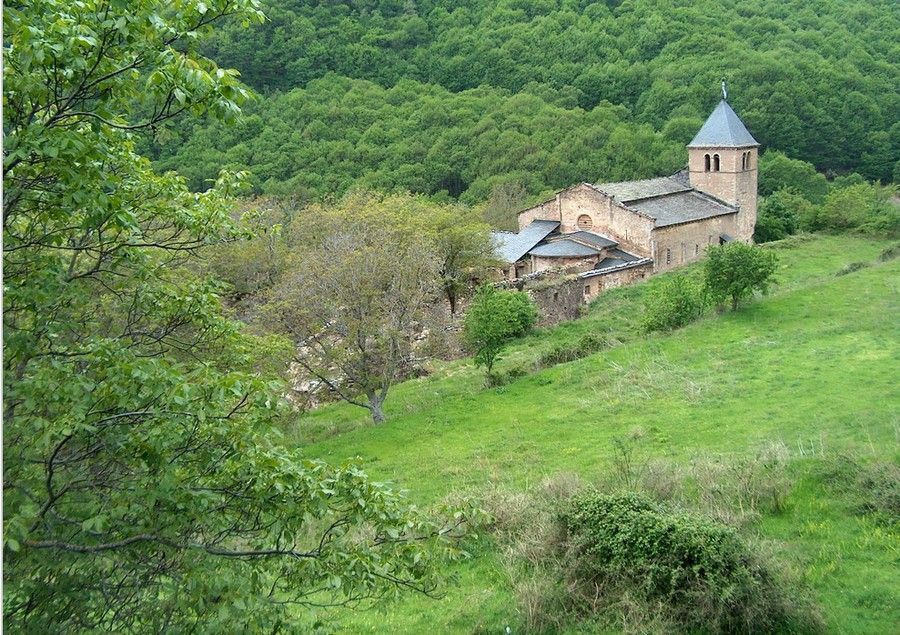SAN PEDRO DE MONTES

Environnement historique
Lea small village of Montes de Valdueza, belonging to the municipality of Ponferrada, is located in the heart of ‘Tebaida Berciana’ and rises in the shadow of the ruphianense monastery, later known as San Pedro (and San Pablo) de Montes. The town, practically deserted in winter, is located in the heart of the Aquilanos Mountains, in a place that in 1969 was declared a ‘Picturesque Set of Tourist Interest’.
At present, very little is preserved from its first moments (VII-X centuries), except for some ornamental remains (inscription, capitals, fabrics). Today we can admire its church, from the ss. XII-XIII, and some of its cloistered rooms, already greatly modified from the XVI-XVIII centuries: fishery, kitchen, etc. The entire complex, which appears surrounded by a wall from the s. XVI, is undergoing extensive restoration and rehabilitation since the year 2000.
Description
From the first period of the monastery some remains are preserved, such as the epigraph of consecration (carried out from the year 940) or the capitals that we find on the north side of the tower, dated between the 7th and 10th centuries. P But of special relevance are the decorative remains (reliefs and inscriptions) embedded in the walls of a small hermitage built by the monks of San Pedro in 1723 -and which has been recently restored- on a steep rock at the entrance of the town, very close to the location that tradition gives to a small building that, dedicated to the Holy Cross and Saint Pantaleon, erected by Saturnino, a disciple of Saint Valerius and consecrated in the s. VII by Aurelio, Bishop of Astorga.
But of special relevance are the decorative remains (reliefs and inscriptions) embedded in the walls of a small hermitage built by the monks of San Pedro in 1723 -and which has been recently restored- on a steep rock at the entrance of the town, very close to the location that tradition gives to a small building that, dedicated to the Holy Cross and Saint Pantaleon, erected by Saturnino, a disciple of Saint Valerius and consecrated in the s. VII by Aurelio, Bishop of Astorga.
Due to topographic conditions, the multiple extensions suffered and the fires that occurred in the s. XIX, the few remains of preserved monastic dependencies configure a plan somewhat irregular and difficult to specify. To the south of the church, located appears the ‘Cloister of the Arches’, built in the s. XVI very probably on the medieval cloister. And to the east of the church are rooms such as the kitchen and the basement of what, in other times, was a cellar.
With the exception of its neoclassical façade (carried out around 1756), the fabric of the church, erected between the 12th and 13th centuries, was erected with regular masonry. The building presents a planimetric typology that is very common among monastic churches: a basilica plan with three naves, a transept not accused in plan and a triabsidized chancel. At the foot of the nave is a space resembling a baptistery and at the foot of the north is the bell tower with a quadrangular floor plan and thick slate masonry walls reinforced by irregular blocks of tuff stone and limestone in the corners. Already in the 17th-18th centuries, the pillars of the nave were reinforced and the sacristy and the ‘dressing room of the Virgin’ were built. It is also worth noting the existence of a high choir at the foot of the temple; choir in which  keep, in not too good a state of conservation, a chair on whose backs important figures for the history of the monastery were represented, such as San Fructuoso, San Valerio or Saint Gennadio, among others. This stall was made in the times of Abbot Genadio del Olivar (1686-1689).
keep, in not too good a state of conservation, a chair on whose backs important figures for the history of the monastery were represented, such as San Fructuoso, San Valerio or Saint Gennadio, among others. This stall was made in the times of Abbot Genadio del Olivar (1686-1689).
Aspects such as the appearance of ribs in the apsidal roofs, the existence of wide presbyterial sections, the presence of oculi or circular openings or the Poitevin lighting system lead many authors to place the completion of the building in the 13th century.
Among the best preserved medieval remains is the door that connects the church with the ‘Cloister of the Arches’, a work from the end of the s. XII – s. XIII, which has been recently reopened; The access, which is very sober and simple, consists of a semicircular arch on angled columns with finely carved capitals and phytomorphic decoration based on fleshy, but at the same time, stylized acanthus leaves on a roped talus with pre-Romanesque roots. .
Among the many treasures that are still kept in the temple after the looting suffered in 1982, there is a polychrome wood carving -dating from the ss. XII-XIII- representing Christ seated on a backless throne, dressed in a cloak and tunic under which his bare feet appear. In his left hand he carries a closed book, while with his right he blesses .
Artemio M. Martínez Tejera for URBS REGIA



